
The Jefferson Theatre is a historic performing arts theatre located on Fannin Street in downtown Beaumont, Texas. Designed by Emile Weil and built in 1927, it is an example of Old Spanish architecture and seats over 1400. The theatre was built by Jefferson Amusement Company, which was owned by Saenger Amusements. The theatre is featured on the National Register of Historic Places and recognized as a Recorded Texas Historic Landmark. The theatre recently underwent a comprehensive multimillion-dollar renovation. It is also one of the few theatres in the country containing its original Morton organ, produced by the Robert Morton Organ Company.

Battle Hall, also known as the "Cass Gilbert Building" and "The Old Library," is a historic library on the campus of the University of Texas at Austin in Austin, Texas. It is one of four buildings on campus that have been added to the National Register of Historic Places. The others are the Littlefield House, University Junior High School and Little Campus.

The Simon Theatre is a theater in Brenham, Texas. It was built by James Simon, designed by Houston architect Alfred C. Finn, and constructed in 1925. For many decades the Simon Theatre provided the community with a setting for theatrical performances, vaudeville acts, ballroom dances, special events and movies.
The Montgomery Ward Building in downtown San Angelo, Texas was a historic department store building designed by architect Oscar Ruffini. It was built in 1927 and was listed on the National Register of Historic Places in 1988.

The Julie Rogers Theatre is a historic performing arts theatre located on Pearl Street in downtown Beaumont, Texas. Built in 1928, the theatre was once Beaumont's City Hall and Auditorium. The capacity is approximately 1,663 seats.
The Crockett Street Dining and Entertainment Complex is located in Downtown Beaumont, Texas. It consists of five restored buildings built at the turn of the 20th century. They were used for various businesses then, but now host restaurants and various entertainment venues. From left to right, the historic names are: Wilson Building, Littleton Building, Millard Building, Dixie Hotel.

The Jack Brooks Federal Building is a federal office building in Beaumont, Texas. Completed during the Great Depression in 1933, it was the United States Post Office and Federal Building. The building houses courtrooms and chambers of the United States District Court for the Eastern District of Texas, and an office of the United States Postal Service. In 1978, President Jimmy Carter came to Beaumont to officiate over the renaming of the building for Congressman Jack Brooks, who lived in and represented the area for many years.

The Goodhue Building is an office building in the downtown area of Beaumont, Texas. Built in 1926 by Forrest Goodhue, the building has 190 offices and is one of the most decorative structures in the area. The building has 11 stories and a penthouse. The building was built in a Tudor gothic style by Tisdale, Stone & Pinson, with an asymmetric penthouse.
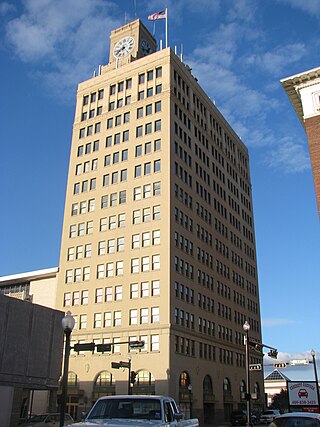
The San Jacinto Building in Beaumont, Texas was built between 1921–1922 and was completed for the San Jacinto Life Insurance Company. The building is 15 stories tall and supports a large clock tower on top. Each dial is 17 feet in diameter. The building was altered in the 1950s with the removal of a "cupola" and the cornice that surrounded the building. It is privately owned today and is used as an office building. The building contributes to the Beaumont Commercial District.

The Hotel Beaumont is a historic, currently vacant hotel structure on Orleans Street near Pearl Street in Beaumont, Texas.
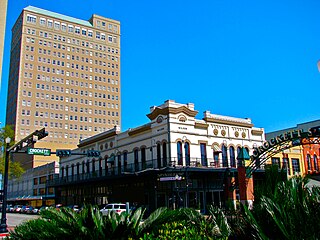
The Beaumont Commercial District is located in Downtown Beaumont, Texas. The district consists of various styles of buildings, including 6 highrises built before 1932. The district is registered on the National Register of Historic Places as a U.S. Historic District. The historic district is roughly bounded by Willow, Neches, Gilbert and Main Streets. The Old Spanish Trail travels through Downtown on Willow, Park, Pearl and College Streets.

The Edson Hotel in Beaumont, Texas was built in 1929 at a cost of $1.5 Million, and was designed by F.W. and D.E. Steinman of Beaumont. The building is 22 stories tall. The building was bought in 1955 by Gulf States Utilities, and has been an office building ever since.
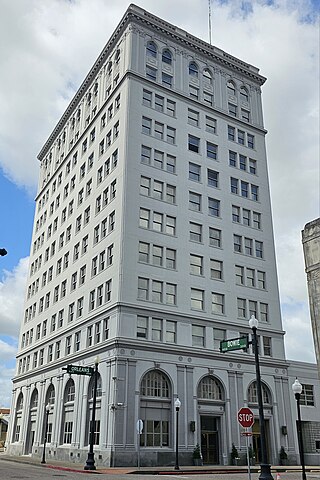
The Orleans Building in Beaumont, Texas was built in 1925 for the American National Bank. It is located at 470 Orleans St. in Downtown Beaumont. The building is 12 stories tall.
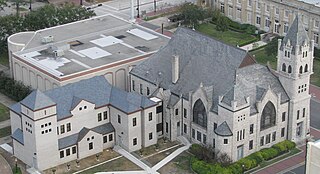
The Tyrrell Historical Library is a public library in Beaumont, Texas. Originally built in 1903 to serve as the First Baptist Church, the building displays a mix of Richardsonian Romanesque and Victorian Gothic architectures, with pointed arch windows and quatrefoils, and all of its original stained glass. The building became vacant in 1923 when the congregation moved to a new location. It was bought by Captain W. C. Tyrrell, who donated the building to the city for use as its first public library. The building is listed in the National Register of Historic Places and also as a Recorded Texas Historic Landmark. It is also a contributing property to the Downtown Historic District.

The Kyle Building was built in 1933 in downtown Beaumont, Texas. It was designed as a retail storefront, with two-story offices at each end of the building. It is located at 215 Orleans St. The building contains 11 stores, and it is an excellent example of Zig-Zag Art Deco architecture. A contributing property to the Beaumont Historic District, it is located at the site of the former Kyle Opera house, which was demolished in 1931.

The First National Bank Building in downtown Beaumont, Texas was built in 1937 and is an excellent example of Art Deco architecture. The building is four stories tall and decorated with reliefs of workers and business people designed by Beaumont-based sculptor Matchett Herring Coe.
Downtown Beaumont is the central business district of Beaumont, Texas. It is where the city's highrise buildings are located, as well as being the center of government and business for the region. Downtown Beaumont is currently experiencing a renaissance, with streets, sidewalks and historic buildings receiving significant attention.

The First City Building was built in 1962 for the First Security National Bank. The five-story building was built by renowned architect L.W. Pitts and built in the modernism style. It is known for its facade of cast concrete, sculpted by Beaumont artist Herring Coe, designed to reflect the sun and reduce cooling costs. The building is used as offices today.
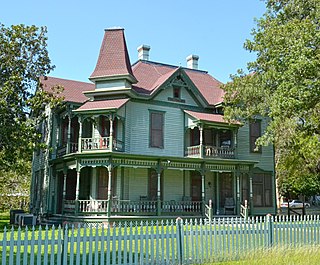
The Dr. L.W. and Martha E.S. Chilton House at 242 N. Chilton St. in Goliad, Texas, United States, was built in 1902. It was a work of architect Jules Leffland and of building contractor Bailey Mills. It was listed on the National Register of Historic Places in 1998. The listing included two contributing buildings and two contributing structures.

Texas Hall is a historic building on the former campus of Trinity University in Tehuacana, Texas, U.S.. The land was donated by John Boyd. It was first designed in the Gothic Revival style by Joseph Schuster, and completed in 1871. It was subsequently redesigned by architect James E. Flanders in the Second Empire style between 1886 and 1892. Trinity University relocated to Waxahachie, Texas in 1902, and Westminster College moved into the building, up until 1942. The building is now known as the Trinity Institute.
























